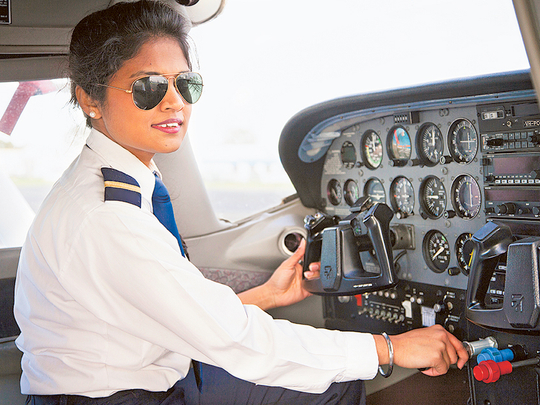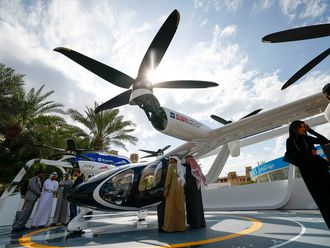
Sophia Kuo says she still hears the whispers as she walks through international airports in her EVA Airways Corp pilot’s uniform: “’Wow, we have female pilots.’ ‘How does she fly an airplane?’ ‘She must be really smart!”’ More than eight decades after Amelia Earhart’s solo flight across the Atlantic, women like Kuo, a 35-year-old co-pilot on the Taiwanese carrier’s Boeing 747s, remain the exception in the cockpit. Only about 5 per cent of pilots globally are female, according to Liz Jennings Clark, chairwoman of the International Society of Women Airline Pilots.
And just “a tiny” percentage of them are captains.
Now, airlines are being forced to balance the scale because a rapid escalation in air travel in Asia may leave the industry desperately short of pilots. The region is transporting 100 million new passengers every year, said Sherry Carbary, vice-president of flight services for Boeing Co., which assists airlines in training new pilots.
To fly all those aspiring new middle-class, Asia is going to need another 226,000 pilots in the next two decades, according to Boeing. “There is such an enormous demand to meet the growth that the gender bias will have to be pushed aside,” Carbary said.
Some carriers are trying. Vietnam Airlines Corp, based in what the International Air Transport Association forecasts will be one of the world’s 10 fastest-growing aviation markets, is creating work schedules that take into account demands of family life.
UK-based EasyJet Plc has set up a scholarship with the British Women Pilots Association to underwrite the costs of training women pilots.
Recruitment advertisements increasingly feature women. British Airways Plc has a photo of a female pilot on its hiring website, while EVA Air, which has about 50 women among its 1,200 pilots, has recruited from universities in Taiwan with ads showing Kuo.
Even so, it takes a long time for someone to gain the training, knowledge and experience to fly an airliner. Most major carriers require flight captains to have 3,000 hours or more of commercial flying experience, not including the time taken to qualify from flight school. Women recruited today on legacy carriers wouldn’t be ready to take charge of a plane for 12 to 15 years, said Clark, a captain with Transavia, a subsidiary of Air France-KLM Group.
“Finding capable flight crews isn’t easy,” said Richard Yeh, who oversees pilot training at EVA Air, which is trying to hire 100 pilots a year to meet demand. “We have to try to find more pilots like Sophia.”
Asia isn’t the only place that will have to find and train thousands of new pilots. Seven of the 10 fastest-growing aviation markets in percentage terms are in Africa. Globally, the number of air travelers is expected to double to seven billion by 2034, according to the International Air Transport Association.
The need to add pilots quickly has led to some flight schools to take shortcuts or issue licenses to pilots who haven’t flown the required number of hours. A lawsuit last year in India accused one school of granting a license to a trainee who had spent only 35 minutes in the air.
Even at bona fide training colleges in Asia, the number of female students remains low. Frequently less than 10 per cent of the 200 cadets at Malaysian Flying Academy Sdn Bhd are female, said Stephen Terry, the school’s principal. The two-year programme costs about $77,000.
“Some carriers in Asia won’t even consider hiring women pilots,” he said, while others prohibit mixed crew from sharing bunk compartments on long-haul flights.
Part of the gender bias is due to the traditional division of roles on a plane, with men - typically white men - up front, and women at the back serving drinks and handing out blankets. Mireille Goyer, founder of the Vancouver-based Institute for Women of Aviation Worldwide, says society has done little to encourage women to seek careers in the cockpit.
That attitude has reduced an already small pool of potential pilots. To qualify for a license to captain a plane, you need to read, write and speak English fluently, have thousands of hours of flight time, no criminal record or history of alcohol abuse and are free of a long list of medical conditions including color blindness and diabetes that requires medication. Ideally, you need to be the sort of person who doesn’t panic easily.
“Pilot personality traits and aptitudes are rare within the human population regardless of gender or race,” Goyer said. “Arbitrarily reducing the potential pool to mostly white males has strangled growth and led to today’s situation. Now there is pressure and momentum to change.”
For women, there are additional hurdles beyond the attitude of co-workers and society, including an historical lack of support for those who want to fly planes and raise a family.
“Flying time for female pilots may be limited due to maternity leave or the fact they need time to take care of their kids,” LuuHoang Minh, a Vietnam Airlines flight crew deputy director said in an e-mail. He said his company takes these factors into account and tries to arrange flying schedules that help women.
The carrier, which has 11 female pilots out of 1,058, expects to fly 19.2 million passengers this year, 2 million more than in 2015.
In regions like Asia, where traditional attitudes toward a woman’s role are stronger, it’s even harder for women to make the step to the pilot’s role, said Kit Darby, a former United Continental Holdings Inc captain who works as a consultant. Being a commercial pilot is still viewed “as a single man’s game,” he said.
Vietnam Airlines Captain Huynh Ly Dong Phuong says her mother was initially reluctant to approve of her career choice and even now she is sometimes treated differently from male colleagues. “My difficulty is making people accept the fact I am a pilot first and a female second, not the other way around,” she said in an e-mail.
Yet commercial jets don’t need the cocky fighter-pilot attitude featured in the 1986 Hollywood movie “Top Gun”, starring Tom Cruise, said Graham Hunt, head of Embry-Riddle Aeronautical University Asia in Singapore. Flying an airliner “is not about being a gungho fighter pilot, it’s about monitoring complex systems, decision-making, collaboration,” he said.
Still, the romance of the fighter pilot endures. First officer Kuo fell in love with flying as a child when she saw a fighter jet take off. “I love to fly,” Kuo said. As she speeds down the runway and the plane noses skyward, “everything in front of you becomes very small. Your view of life changes.”












